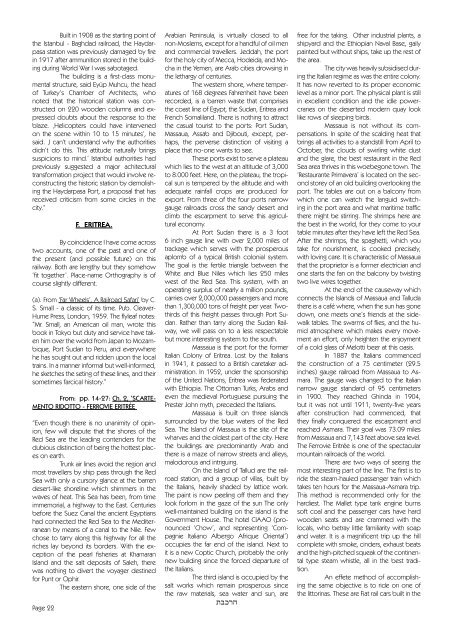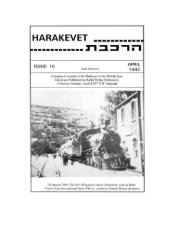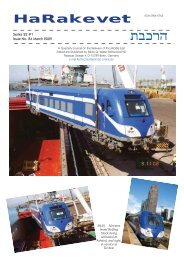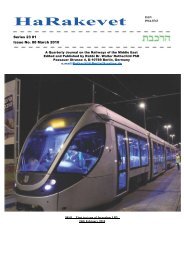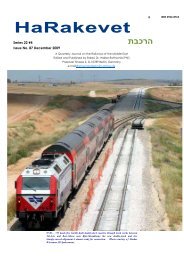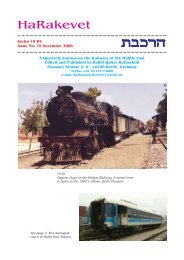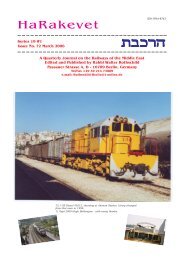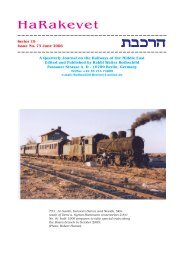Create successful ePaper yourself
Turn your PDF publications into a flip-book with our unique Google optimized e-Paper software.
Built in 1908 as the starting point of<br />
the Istanbul - Baghdad railroad, the Haydarpasa<br />
station was previously damaged by fire<br />
in 1<strong>91</strong>7 after ammunition stored in the building<br />
during World War I was sabotaged.<br />
The building is a first-class monumental<br />
structure, said Eyüp Muhcu, the head<br />
of Turkey‘s Chamber of Architects, who<br />
noted that the historical station was constructed<br />
on 220 wooden columns and expressed<br />
doubts about the response to the<br />
blaze. ‚Helicopters could have intervened<br />
on the scene within 10 to 15 minutes‘, he<br />
said. ‚I can‘t understand why the authorities<br />
didn‘t do this. This attitude naturally brings<br />
suspicions to mind.‘ Istanbul authorities had<br />
previously suggested a major achitectural<br />
transformation project that would involve reconstructing<br />
the historic station by demolishing<br />
the Haydarpasa Port, a proposal that has<br />
received criticism from some circles in the<br />
city.“<br />
Page 22<br />
F. ERITREA.<br />
By coincidence I have come across<br />
two accounts, one of the past and one of<br />
the present (and possible future) on this<br />
railway. Both are lengthy but they somehow<br />
‘fit together’. Place-name Orthography is of<br />
course slightly different.<br />
(a). From ‘Far Wheels’, A Railroad Safari’ by C.<br />
S. Small - a classic of its time. Pub. Cleaver-<br />
Hume Press, London, 1959. The flyleaf notes:<br />
“Mr. Small, an American oil man, wrote this<br />
book in Tokyo but duty and service have taken<br />
him over the world from Japan to Mozambique,<br />
Port Sudan to Peru, and everywhere<br />
he has sought out and ridden upon the local<br />
trains. In a manner informal but well-informed,<br />
he sketches the seting of these lines, and their<br />
sometimes farcical history.”<br />
From: pp. 14-27: Ch. 2, ‘SCARTE-<br />
MENTO RIDOTTO - FERROVIE ERITRÉE<br />
“Even though there is no unanimity of opinion,<br />
few will dispute that the shores of the<br />
Red Sea are the leading contenders for the<br />
dubious distinction of being the hottest places<br />
on earth.<br />
Trunk air lines avoid the region and<br />
most travellers by ship pass through the Red<br />
Sea with only a cursory glance at the barren<br />
desert-like shoreline which shimmers in the<br />
waves of heat. This Sea has been, from time<br />
immemorial, a highway to the East. Centuries<br />
before the Suez Canal the ancient Egyptians<br />
had connected the Red Sea to the Mediterranean<br />
by means of a canal to the Nile. Few<br />
chose to tarry along this highway for all the<br />
riches lay beyond its borders. With the exception<br />
of the pearl fisheries at Khamaran<br />
Island and the salt deposits of Saleh, there<br />
was nothing to divert the voyager destined<br />
for Punt or Ophir.<br />
The eastern shore, one side of the<br />
Arabian Peninsula, is virtually closed to all<br />
non-Moslems, except for a handful of oil men<br />
and commercial travellers. Jeddah, the port<br />
for the holy city of Mecca, Hodeida, and Mocha<br />
in the Yemen, are Arab cities drowsing in<br />
the lethargy of centuries.<br />
The western shore, where temperatures<br />
of 168 degrees Fahrenheit have been<br />
recorded, is a barren waste that comprises<br />
the coast line of Egypt, the Sudan, Eritrea and<br />
French Somaliland. There is nothing to attract<br />
the casual tourist to the ports: Port Sudan,<br />
Massaua, Assab and Djibouti, except, perhaps,<br />
the perverse distinction of visiting a<br />
place that no-one wants to see.<br />
These ports exist to serve a plateau<br />
which lies to the west at an altitude of 3,000<br />
to 8.000 feet. Here, on the plateau, the tropical<br />
sun is tempered by the altitude and with<br />
adequate rainfall crops are produced for<br />
export. From three of the four ports narrow<br />
gauge railroads cross the sandy desert and<br />
climb the escarpment to serve this agricultural<br />
economy.<br />
At Port Sudan there is a 3 foot<br />
6 inch gauge line with over 2,000 miles of<br />
trackage which serves with the prosperous<br />
aplomb of a typical British colonial system.<br />
The goal is the fertile triangle between the<br />
White and Blue Niles which lies 250 miles<br />
west of the Red Sea. This system, with an<br />
operating surplus of nearly a million pounds,<br />
carries over 2,000,000 passengers and more<br />
than 1,300,000 tons of freight per year. Twothirds<br />
of this freight passes through Port Sudan.<br />
Rather than tarry along the Sudan Railway,<br />
we will pass on to a less respectable<br />
but more interesting system to the south.<br />
Massaua is the port for the former<br />
Italian Colony of Eritrea. Lost by the Italians<br />
in 1941, it passed to a British caretaker administration.<br />
In 1952, under the sponsorship<br />
of the United Nations, Eritrea was federated<br />
with Ethiopia. The Ottoman Turks, Arabs and<br />
even the medieval Portuguese pursuing the<br />
Prester John myth, preceded the Italians.<br />
Massaua is built on three islands<br />
surrounded by the blue waters of the Red<br />
Sea. The Island of Massaua is the site of the<br />
wharves and the oldest part of the city. Here<br />
the buildings are predominantly Arab and<br />
there is a maze of narrow streets and alleys,<br />
malodorous and intriguing.<br />
On the Island of Tallud are the railroad<br />
station, and a group of villas, built by<br />
the Italians, heavily shaded by lattice work.<br />
The paint is now peeling off them and they<br />
look forlorn in the gaze of the sun The only<br />
well-maintained building on the island is the<br />
Government House. The hotel CIAAO (pronounced<br />
‘Chow’, and representing ‘Compagnie<br />
Italiano Albergo Afrique Oriental’)<br />
occupies the far end of the island. Next to<br />
it is a new Coptic Church, probably the only<br />
new building since the forced departure of<br />
the Italians.<br />
The third island is occupied by the<br />
salt works which remain prosperous since<br />
the raw materials, sea water and sun, are<br />
,cfrv<br />
free for the taking. Other industrial plants, a<br />
shipyard and the Ethiopian Naval Base, gaily<br />
painted but without ships, take up the rest of<br />
the area.<br />
The city was heavily subsidised during<br />
the Italian regime as was the entire colony.<br />
It has now reverted to its proper economic<br />
level as a minor port. The physical plant is still<br />
in excellent condition and the idle powercranes<br />
on the deserted modern quay look<br />
like rows of sleeping birds.<br />
Massaua is not without its compensations.<br />
In spite of the scalding heat that<br />
brings all activities to a standstill from April to<br />
October, the clouds of swirling white dust<br />
and the glare, the best restaurant in the Red<br />
Sea area thrives in this woebegone town. The<br />
‘Restaurante Primavera’ is located on the second<br />
storey of an old building overlooking the<br />
port. The tables are out on a balcony from<br />
which one can watch the languid switching<br />
in the port area and what maritime traffic<br />
there might be stirring. The shrimps here are<br />
the best in the world, for they come to your<br />
table minutes after they have left the Red Sea.<br />
After the shrimps, the spaghetti, which you<br />
take for nourishment, is cooked precisely,<br />
with loving care. It is characteristic of Massaua<br />
that the proprietor is a former electrician and<br />
one starts the fan on the balcony by twisting<br />
two live wires together.<br />
At the end of the causeway which<br />
connects the Islands of Massaua and Talluda<br />
there is a café where, when the sun has gone<br />
down, one meets one’s friends at the sidewalk<br />
tables. The swarms of flies, and the humid<br />
atmosphere which makes every movement<br />
an effort, only heighten the enjoyment<br />
of a cold glass of Melotti beer at this oasis.<br />
In 1887 the Italians commenced<br />
the construction of a 75 centimeter (29.5<br />
inches) gauge railroad from Massaua to Asmara.<br />
The gauge was changed to the Italian<br />
narrow gauge standard of 95 centimeters<br />
in 1900. They reached Ghinda in 1904,<br />
but it was not until 1<strong>91</strong>1, twenty-five years<br />
after construction had commenced, that<br />
they finally conquered the escarpment and<br />
reached Asmara. Their goal was 73.09 miles<br />
from Massaua and 7,143 feet above sea level.<br />
The Ferrovie Eritrée is one of the spectacular<br />
mountain railroads of the world.<br />
There are two ways of seeing the<br />
most interesting part of the line. The first is to<br />
ride the steam-hauled passenger train which<br />
takes ten hours for the Massaua-Asmara trip.<br />
This method is recommended only for the<br />
hardiest. The Mallet type tank engine burns<br />
soft coal and the passenger cars have hard<br />
wooden seats and are crammed with the<br />
locals, who betray little familiarity with soap<br />
and water. It is a magnificent trip up the hill<br />
complete with smoke, cinders, exhaust beats<br />
and the high-pitched squeak of the continental<br />
type steam whistle, all in the best tradition.<br />
An effete method of accomplishing<br />
the same objective is to ride on one of<br />
the littorinas. These are Fiat rail cars built in the


